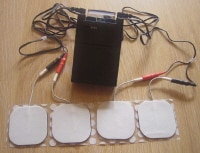Transcutaneous electrical nerve
stimulation (TENS) currently is one of the most commonly used forms of
electroanalgesia. Hundreds of clinical reports exist concerning the use
of TENS for various types of conditions, such as (LBP), myofascial and arthritic pain, sympathetically mediated pain, pain, visceral pain, and .
Because many of these studies were uncontrolled, there has been ongoing
debate about the degree to which TENS is more effective than placebo in
reducing pain.[1, 2, 3, 4]
The image below depicts a TENS unit.
 TENS (Transcutaneous Electrical Nerve Stimulator). Image courtesy of Wikimedia Commons. The currently proposed mechanisms by which TENS produces neuromodulation include the following:
TENS (Transcutaneous Electrical Nerve Stimulator). Image courtesy of Wikimedia Commons. The currently proposed mechanisms by which TENS produces neuromodulation include the following:
Studies show marked increases in beta endorphin and met-enkephalin with low-frequency TENS, with demonstrated reversal of the antinociceptive effects by naloxone.[6] These effects have been postulated to be mediated through micro-opioid receptors. Research indicates, however, that high-frequency TENS analgesia is not reversed by naloxone, implicating a naloxone-resistant, dynorphin-binding receptor. A sample of cerebral spinal fluid in those subjects demonstrated increased levels of dynorphin A.
The mechanism of the analgesia produced by TENS is explained by the gate-control theory proposed by Melzack and Wall in 1965.[7] The gate usually is closed, inhibiting constant nociceptive transmission via C fibers from the periphery to the T cell. When painful peripheral stimulation occurs, however, the information carried by C fibers reaches the T cells and opens the gate, allowing pain transmission centrally to the thalamus and cortex, where it is interpreted as pain. The gate-control theory postulates a mechanism by which the gate is closed again, preventing further central transmission of the nociceptive information to the cortex. The proposed mechanism for closing the gate is inhibition of the C-fiber nociception by impulses in activated myelinated fibers.
The image below depicts a TENS unit.
 TENS (Transcutaneous Electrical Nerve Stimulator). Image courtesy of Wikimedia Commons. The currently proposed mechanisms by which TENS produces neuromodulation include the following:
TENS (Transcutaneous Electrical Nerve Stimulator). Image courtesy of Wikimedia Commons. The currently proposed mechanisms by which TENS produces neuromodulation include the following:- Presynaptic inhibition in the dorsal horn of the spinal cord
- Endogenous pain control (via endorphins, enkephalins, and dynorphins)[5]
- Direct inhibition of an abnormally excited nerve
- Restoration of afferent input
Studies show marked increases in beta endorphin and met-enkephalin with low-frequency TENS, with demonstrated reversal of the antinociceptive effects by naloxone.[6] These effects have been postulated to be mediated through micro-opioid receptors. Research indicates, however, that high-frequency TENS analgesia is not reversed by naloxone, implicating a naloxone-resistant, dynorphin-binding receptor. A sample of cerebral spinal fluid in those subjects demonstrated increased levels of dynorphin A.
The mechanism of the analgesia produced by TENS is explained by the gate-control theory proposed by Melzack and Wall in 1965.[7] The gate usually is closed, inhibiting constant nociceptive transmission via C fibers from the periphery to the T cell. When painful peripheral stimulation occurs, however, the information carried by C fibers reaches the T cells and opens the gate, allowing pain transmission centrally to the thalamus and cortex, where it is interpreted as pain. The gate-control theory postulates a mechanism by which the gate is closed again, preventing further central transmission of the nociceptive information to the cortex. The proposed mechanism for closing the gate is inhibition of the C-fiber nociception by impulses in activated myelinated fibers.
No comments :
Post a Comment